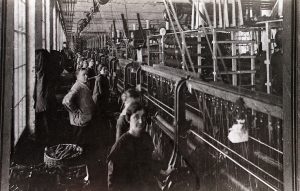Women Work for Wages
Women’s Work is Not Just Inside the Home…
Women worked for wages. In Maine they have worked as sardine packers, herring smokers, machine operators, potato pickers, blueberry rakers, broccoli harvesters, telephone operators, shoe makers, clothing and textile workers, secretaries and store clerks and paper makers. They worked in war industries during WWII and also took part in the time-honored traditional roles of nurses and teachers. What else do women do? Little research has been conducted on female rural workers in Maine. How is Maine’s story different form other regions of the country? We’d like to find out.
See the blurbs below to find out of the work women did in the region and the women who did the work.
Mill Work

P08196: Interior of Old Town Woolen Mill.
“I worked in the Old Town Mills, starting when I was 14. We went over to visit Mr. Gessner and Jessie (his daughter) had just come home from the woolen mill. She was 14 and she said, “Maggie, you want a job?”
And I said “What doing?”
She said, “spooling, up at the woolen mill.”
And I said, “young as you are?”
She said “yes, they wanted a spooler. You want to come up and try?”
And I said, “Why, yes, I’ll go!”I was tickled to death, I got my dinner pail all ready and I was out on the bank at 5 o’clock in the morning because I was afraid that the Gessners would go by without picking me up. So when we got to the mill, course I’d never been anywhere like that she didn’t tell me anything about how to spool.” -Margaret Nadeau NA1489
Shoe Manufacturing
- P08196: Interior of Old Town Woolen Mill.
- P08192: Rice & Hutchins, Shoe manufacturing. Four Rod Road, Warren, Maine, 1894. Photo courtesy of Warren Historical Society, permission must obtain from Society prior to use.
The shoe stitchers in P08196 at the Wise & Cooper Company in Lewiston were called from their machines by their floor foreman to pose for this photograph circa 1910. The age range of the women suggests that many may have worked in the shoe factory throughout their adult lives, perhaps juggling family responsibilities at the same time. Did women with children continue their jobs at the shoe shop? Who took care of the children?
Store Work
![The girl behind the counter in the white dress was working at another 'female' occupation, that of store clerk. Her job was unusual, however, because in this photo she is working at Russell's Hardware Store in Rangeley, Maine, in 1924. [P 6529]](https://umaine.edu/folklife/wp-content/uploads/sites/312/2010/02/P6529a-300x193.jpg)
War Jobs
New England Shipbuilding Corporation:
During WWII many women took jobs previously held only by men. When the war ended, the women were let go and their jobs were given to returning soldiers.
![New England Shipbuilding Corporation, taken April 28, 1944. A woman welder wearing leathers and a helmet while speaking to Lowell Thomas, a famous newsman. This type of propaganda was produced during the war to encourage women to go to work in the war industries, but the true attraction for many women like this welder was the higher wages they received for welding and other non-traditional jobs. [P 5377]](https://umaine.edu/folklife/wp-content/uploads/sites/312/2010/02/P5377a-300x223.jpg)
New England Shipbuilding Corporation, taken April 28, 1944. In P05377, a woman welder wearing leathers and a helmet speaks to Lowell Thomas, a famous newsman. This type of propaganda was produced during the war to encourage women to go to work in the war industries, but the true attraction for many women like this welder was the higher wages they received for welding and other non-traditional jobs.
Saco-Lowell Foundry:
![Ethel Linscott and an unidentified co-worker, working in the core room at the Saco-Lowell Foundry in Biddeford, Maine sometime in 1942 or 1943. "I worked in what they called the core room. You can imagine the jokes that come from that! Talk about pounding sand, that's where you pound sand! The sand was mixed with oil, and you had molds, and you pounded this sand into the molds. Then you had to take the sides off the molds very carefully to get the things to come apart without falling apart. My hands weren't as delicate as they should be, and this was quite a job." [P 5252] [NA 1532.007]](https://umaine.edu/folklife/wp-content/uploads/sites/312/2010/02/P5252a-300x228.jpg)
“I worked in what they called the core room. You can imagine the jokes that come from that! Talk about pounding sand, that’s where you pound sand! The sand was mixed with oil, and you had molds, and you pounded this sand into the molds. Then you had to take the sides off the molds very carefully to get the things to come apart without falling apart. My hands weren’t as delicate as they should be, and this was quite a job.” -Ethel Linscott NA1532.007
US Women’s Army Corps:
![P08211: First Lieutenant Reta L. Graham. US Women's Army Corps, School Instructor. [NA 2532] Women's Work: A Century of Maine's Experience](https://umaine.edu/folklife/wp-content/uploads/sites/312/2010/02/P8211a-300x236.jpg)
experience was put to work for the war effort, as shown in photo P08211 of First Lieutenant Reta L. Graham.
Additional reading:
Blewett, Mary, Men, Women, and Work: Class, Gender, and Protest in the New England Shoe Industry, 1780-1910, (Urbana: University of Illinois, 1988).
Kessler-Harris, Alice, Out to Work, (New York:Oxford University Press, 1982).
Smuts, Robert W., Women and Work in America, (New York: Columbia University Press, 1959)

![P08192: Rice & Hutchins, Shoe manufacturing. Four Rod Road, Warren, Maine, 1894. [Warren Historical Society]](https://umaine.edu/folklife/wp-content/uploads/sites/312/2010/02/P8192a-300x209.jpg)